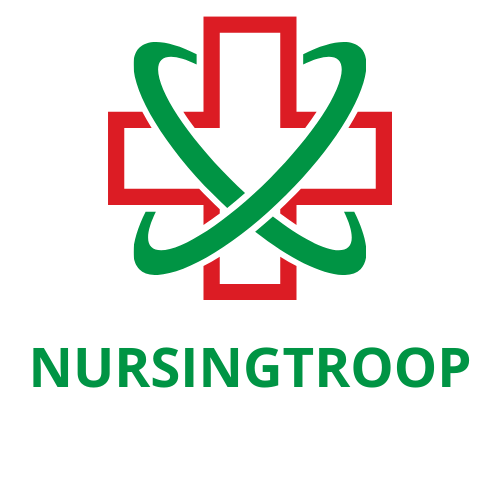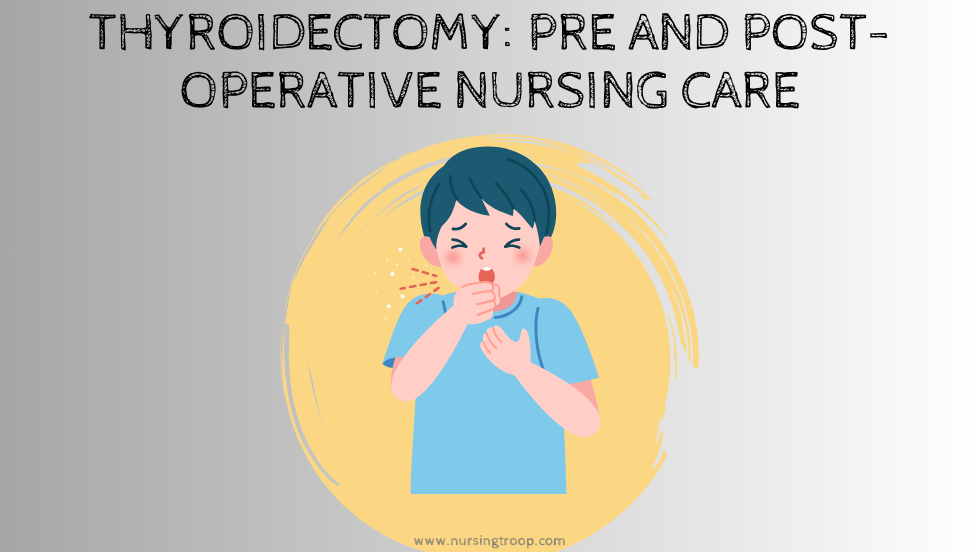A thyroidectomy is an operation performed to remove some or all of the thyroid glands, typically due to a malignancy such as cancer. Occasionally, it may be necessary for other reasons, such as hyperthyroidism and goiter. Pre-operative nursing care is essential in preparing patients for surgery, and postoperative nursing care significantly impacts the patient’s recovery.
In this blog post, we will discuss critical considerations, both preoperatively and Thyroidectomy post-op nursing care, that is vital knowledge for nurses providing discharge teaching, follow-up instructions, and overall support during a Thyroidectomy.
Table of Contents
Thyroidectomy
Before the Procedure
Surgeons typically perform a thyroidectomy under general anesthesia so you won’t be conscious during the procedure. The anesthesiologist or anesthetist will administer anesthetic medication as a gas through a mask or via injection into your vein.
Afterward, a breathing tube will be inserted into your trachea for assistance with breathing throughout the operation. Various monitors are placed on your body to check your heart rate, blood pressure, and oxygen saturation throughout the procedure – including a blood pressure cuff on your arm and heart monitor leads attached to your chest.
During the Procedure
Once you are unconscious, the surgeon will make an incision in the center of your neck, usually positioned where the skin can easily conceal it after the cut has healed. Depending on why you are having a thyroidectomy, all or part of the thyroid gland may be removed.
If there is suspicion of thyroid cancer, lymph nodes surrounding the thyroid may also need to be examined and taken out.
Sometimes, the surgeon may utilize special equipment during the procedure to monitor any irritation to vocal cords and reduce the chances of permanent damage.
Thyroidectomy usually takes 1 to 2 hours. It may take extra or less time, depending on the extent of the surgery.
There are several approaches to Thyroidectomy, including:
- Conventional Thyroidectomy. This is the traditional approach to removing the thyroid. It involves an incision in the neck and is usually performed under general anesthesia.
- Endoscopic Thyroidectomy. This procedure uses tiny instruments placed through minor cuts in the neck to remove all or part of the thyroid gland.
- Laparoscopic Thyroidectomy. Like endoscopic surgery, this procedure uses small tools inserted through minor cuts in the abdomen rather than in the neck.
- Robotic-assisted laparoscopic Thyroidectomy. This combines conventional laparoscopic techniques with robotic technology, enabling surgeons to work more precisely and efficiently.
- Radiofrequency ablation (RFA). This minimally invasive procedure destroys parts of the thyroid gland using high-frequency radio waves delivered via a needle inserted into the neck.
- Transoral Thyroidectomy. This minimally invasive approach involves a single small incision in the mouth and is performed under general anesthesia.
After the Procedure
Once the surgery is complete, you’ll be taken to a recovery room, where you will be closely monitored until you’ve regained consciousness. You may have a tube in your neck that drains fluid from the incision site and supports wrap around your neck to minimize swelling and help reduce discomfort. Your surgeon may also prescribe pain medications and antibiotics to help with healing.
You can go home the same day or the following day. Your doctor will give you instructions about activities that should be avoided for some time after surgery and what signs may indicate that medical attention is necessary.
It’s essential to keep your follow-up appointments with your doctor so they can monitor your recovery process and check for any potential complications. The recovery process may take several weeks, and you’ll need to limit your activities.
Your doctor will probably prescribe medications to help manage pain or discomfort as you heal. You may also receive instructions on caring for the incision site to decrease the risk of infection.
Pre-Operative Nursing Care for Thyroidectomy
Before a thyroidectomy, nurses should provide pre-operative teaching to the patient. Patients must know what to expect during the surgery, including possible risks and complications.
Nurses should also assess the patient’s physical condition, including any allergies or existing medical conditions that may affect the surgery. In addition, nurses should provide information on pain management strategies post-operatively, how to care for the incision site and follow-up appointments with the doctor.
It is also essential for nurses to ensure the patient is well nourished before surgery, as malnutrition can lead to poor wound healing and an increased risk of infection.
Post-Operative Nursing Care for Thyroidectomy
Thyroidectomy nursing post-op care is vital for the patient’s recovery and long-term health. It may include:
1) Managing Post-Op Acute Pain
Postoperative pain following Thyroidectomy may range from mild to moderate in intensity and duration. The management of such discomfort includes the use of both pharmacological and non-pharmacological methods.
Analgesic medication should be prescribed accordingly, while positioning, relaxation techniques, and cold therapy can all help to alleviate pain and ensure a successful recovery.
Ultimately, it is paramount for patients to receive comprehensive pain management to enhance comfort levels during the healing process.
- Monitor the patient’s verbal and nonverbal reports of pain, noting its location, intensity (on a 0-10 scale), and duration.
- Put the patient in a semi-Fowler’s position and support their head and neck with sandbags or small pillows.
- Position the head and neck at a neutral point, providing support during any posture changes. Advise the patient to use their hands for neck support and to avoid overextending it.
- Ensure the call bell and other frequently needed items are within easy reach.
- Offer cool drinks or soft foods like ice cream or popsicles.
- Encourage relaxation methods such as guided imagery, soothing music, and progressive relaxation.
- Give analgesics or throat sprays/tablets to relieve pain as required.
- Provide an ice collar if indicated.
2) Maintaining a Patent Airway Clearance
Maintaining a patent airway for patients undergoing Thyroidectomy is critical for proper oxygenation and ventilation. It is essential to monitor the patient’s respiratory status closely, including their breathing rate, depth, and oxygen levels.
Additionally, ensuring proper positioning, assessing the surgical site frequently for swelling or bleeding that could obstruct the airway, and responding promptly if any respiratory distress or obstruction occurs are all essential steps to ensure a safe recovery.
- Monitor respiratory rate, depth, and work of breathing.
- Assess for signs of airway obstruction such as wheezing, stridor, or dyspnea.
- Change patient positioning frequently to avoid pressure on the surgical site.
- Monitor and assess strategic points in the neck for signs of swelling or bleeding that could affect respiratory status.
- Encourage deep breathing exercises, coughing, and splinting when coughing.
- Monitor oxygen saturation levels as indicated, providing supplemental oxygen if necessary.
- Administer bronchodilators as prescribed to improve airflow in the lungs.
- Provide suctioning or other respiratory treatments as required.
3) Promoting Effective Communication
Effective communication is essential for a successful recovery from Thyroidectomy. Ensuring that the patient understands their postoperative instructions regarding surgical site care, pain management, activity levels, and follow-up appointments is vital. The nurse should also provide information about potential signs or symptoms indicating medical complications.
- Encourage verbalization of feelings related to diagnosis, surgery, and recovery.
- Ask open-ended questions to assess understanding and encourage dialogue between patients and healthcare team members.
- Explain the postoperative instructions using terms that the patient quickly understands.
- Provide printed materials with clear pictures or diagrams to illustrate any treatment techniques or activities needed at home.
- Explain what to expect during recovery, including potential signs or symptoms that could indicate medical complications.
- Ask about any concerns or questions the patient may have regarding their recovery.
- Provide emotional support and encourage family or friends to be involved in healing.
- Reinforce verbal information with written instructions for postoperative care at home.
4) Educating Patients About Postoperative Care
- Following a thyroidectomy procedure, patients need to understand the necessary precautions and lifestyle changes that they must take to ensure a successful recovery.
- Provide instructions about activity levels, including what activities should be avoided during healing.
- Educate patients about potential side effects such as hoarseness and difficulty swallowing.
- Explain postoperative medication guidelines, including when and how to take prescribed medications.
- Advise patients on the importance of adequate nutrition in the healing process and any dietary restrictions that may be necessary.
- Explain wound care instructions, such as keeping the incision site clean and dry and avoiding swimming or strenuous activities until cleared by a physician.
- Provide information about when follow-up visits should occur and what signs may indicate the need for medical attention.
- Review postoperative lifestyle guidelines, such as quitting smoking or avoiding alcohol consumption during recovery.
- Reassure patients about their recovery progress, addressing any fears or concerns they may have.
It is also essential to check in with patients regularly to ensure they adhere to their postoperative instructions and follow the course of treatment prescribed by their doctor. Patients can expect a successful recovery from thyroidectomy surgery with proper care and attention.
5) Preventing Injury
To ensure a safe recovery from Thyroidectomy, taking measures to prevent injury is essential. This includes providing patients with a safe environment and educating them about potential damages that could impede their healing process.
- Assist the patient with ambulation to reduce the risk of falls or injury.
- Provide adequate support for the head and neck when changing positions or transferring in or out of bed.
- Apply skin protection products such as heel/elbow protectors if indicated.
- Keep medical equipment, furniture, and other items away from the bedside which may cause an obstruction or present a tripping hazard.
- Educate patients about proper body mechanics when performing activities of daily living, such as avoiding twisting or bending the neck while dressing.
- Monitor the patient for signs of fatigue, dizziness, or lightheadedness, which may indicate an increased risk of injury.
- Provide safety measures to prevent falls and other potential injuries in the bathroom and home environment.
- Instruct patients about proper wound care techniques to reduce the risk of infection.
6) Administer Medications and Provide Pharmacologic Support
Patients undergoing a thyroidectomy may be prescribed medications to manage their symptoms and promote successful recovery. The nurse needs pharmacological support by administering these medications as prescribed and educating the patient about potential side effects or drug interactions.
- Administer appropriate medications following physician orders.
- Provide education about medication use, including when and how to take each drug.
- Monitor patients for signs of adverse reactions or drug interactions.
- Assess pain levels regularly, providing prompt relief when necessary.
- Encourage increased fluid intake if indicated to prevent dehydration or electrolyte imbalances.
- Instruct patients about proper techniques for self-medication or home monitoring of symptoms.
- Provide information about potential side effects the patient may experience with certain medications.
- Instruct patients to promptly report any changes in their health status or medication regimens to their physician.
These interventions can help ensure a successful recovery from Thyroidectomy by providing adequate pharmacological support for the patient.
Final Words
Thyroidectomy post-op care nursing interventions are essential to ensure a successful recovery and prevent potential complications. Nurses must provide information about postoperative care, educate patients on lifestyle changes, monitor for signs of adverse reactions or drug interactions, and administer medications as prescribed. Patients can expect a successful recovery from thyroidectomy surgery with proper postoperative care and monitoring.
References
- https://en.wikipedia.org/wiki/Thyroidectomy
- https://www.mayoclinic.org/tests-procedures/thyroidectomy/about/pac-20385195
Mrs. Marie Brown has been a registered nurse for over 25 years. She began her nursing career at a Level I Trauma Center in downtown Chicago, Illinois. There she worked in the Emergency Department and on the Surgical Intensive Care Unit. After several years, she moved to the Midwest and continued her nursing career in a critical care setting. For the last 10 years of her nursing career, Mrs. Brown worked as a flight nurse with an air ambulance service. During this time, she cared for patients throughout the United States.

